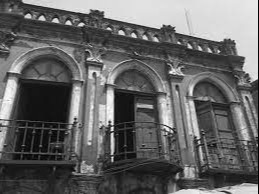After Lagos was ceded to the British by Oba Dosunmu in 1861, many more Saros were encouraged to return to Yorubaland by the colonial administration.
The Saro community lived in the Saro quarter alongside the Afro-Brazilian community in the Brazilian quarter of Lagos.
Like the Afro-Brazilians, they also produced a significant genre of architecture and a distinctive creole culture during the nineteenth century. The Saro architectural style was largely based on a combination of the British colonial style and the Yoruba traditional spatial arrangement.
Although the Saros contributed immensely to the development of architecture in Lagos, they were not nearly as renowned for their building design and construction skills as the Afro-Brazilians were
Doherty house
From 1914 to 1991, Lagos was the federal capital of Nigeria. The progressive substitution of the slave trade with the palm oil industry and the consolidation of the position of Lagos on the West African coast attracted European merchants, freed slaves from Brazil and Cuba, slaves freed by the British on the coast and refugees from the interior.
Master masons like Senhor Lazaro Borges da Silva; Senior Francisco Nobre and Senior Juan Baptista da Costa; master carpenters and cabinet makers like Senior Baltharzar dos Reis; and master painter Senior Walter Paul Siffre enriched the Island with works of architectural beauty, of which a few are still existing.
Ilojo bar or casa de Fernandez prior to demolition
In September 2011, after years of background protests and legal tussles, Ilojo bar, a historic national monument built in 1855 was finally demolished by real estate developers. This is a recurrent theme in our national history; one of destruction (by people who are supposed to be preservers of culture) of our architectural cultural identity in favour of the ultra modern.
This is in part, an architectural reflection of the ascendancy to power of the nouveau riche and their eagerness not to fall behind in the new global age.
Church of all saints
The story of how Benjamin Campbell seduced Brazilians from Bahia and Cubans from Havana back to Lagos is a truly fascinating read.
The then British consul promised security and favourable internal policies in return for the emigres to use their expertise in construction and architecture to build downtown Lagos and beyond.
Shittabey mosque
The immigrants of African descent who began arriving in Lagos and Badagry in the early nineteenth century included not only Afro-Brazilians, but also Afro-Cubans, Afro-Americans, Afro-Canadians (freed slaves from Nova Scotia) and Sierra Leonians (Saros).
Of these, the Afro-Brazilians and the Saros constituted the largest and most dominant groups.
The Afro-Brazilians were the descendants of enslaved Africans (mostly from West Africa and Angola) taken to Brazil who returned to West Africa between the 1820s and 1890s.
Water house
Collectively, in Nigeria the Afro-Brazilians and the Afro-Cubans were referred to as `Brazilians’ or Aguda (Yoruba word for Catholics) probably because the majority of both these groups were Catholics.
The Saros were the descendants of Yoruba slaves from southwestern Nigeria.
Other Saros were African slaves (mostly of Yoruba origin) who have been in England since the early seventeenth century. They were repatriated to Sierra Leone after the abolition of slavery in Great Britain.
After Lagos was ceded to the British by Oba Dosunmu in 1861, many more Saros were encouraged to return to Yorubaland by the colonial administration.
The Saro community lived in the Saro quarter alongside the Afro-Brazilian community in the Brazilian quarter of Lagos.
Like the Afro-Brazilians, they also produced a significant genre of architecture and a distinctive creole culture during the nineteenth century. The Saro architectural style was largely based on a combination of the British colonial style and the Yoruba traditional spatial arrangement.
Although the Saros contributed immensely to the development of architecture in Lagos, they were not nearly as renowned for their building design and construction skills as the Afro-Brazilians were
Doherty house
From 1914 to 1991, Lagos was the federal capital of Nigeria. The progressive substitution of the slave trade with the palm oil industry and the consolidation of the position of Lagos on the West African coast attracted European merchants, freed slaves from Brazil and Cuba, slaves freed by the British on the coast and refugees from the interior.
Master masons like Senhor Lazaro Borges da Silva; Senior Francisco Nobre and Senior Juan Baptista da Costa; master carpenters and cabinet makers like Senior Baltharzar dos Reis; and master painter Senior Walter Paul Siffre enriched the Island with works of architectural beauty, of which a few are still existing.




Leave a reply